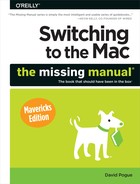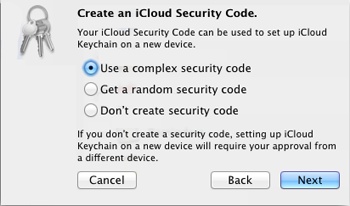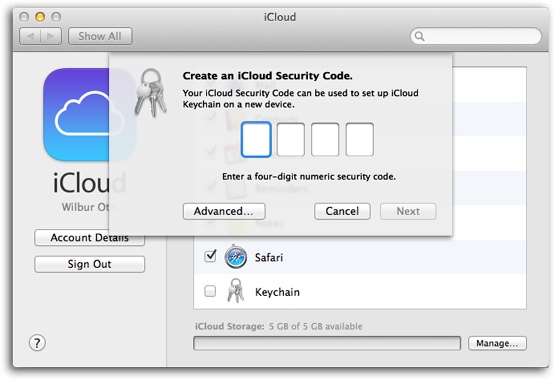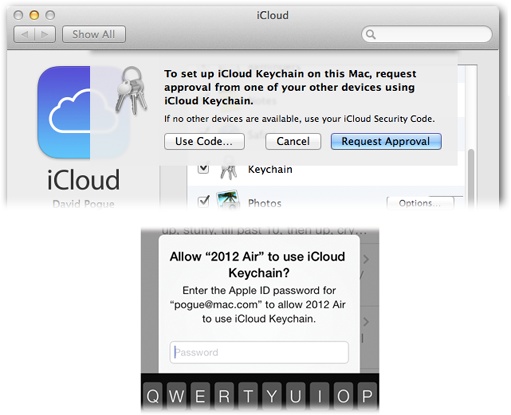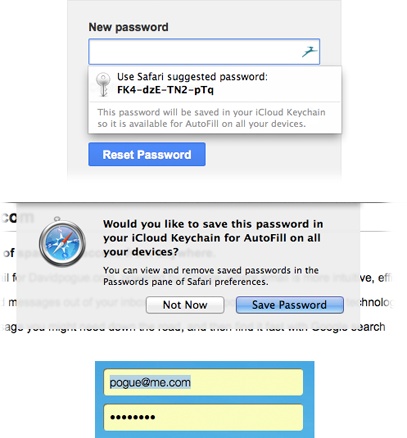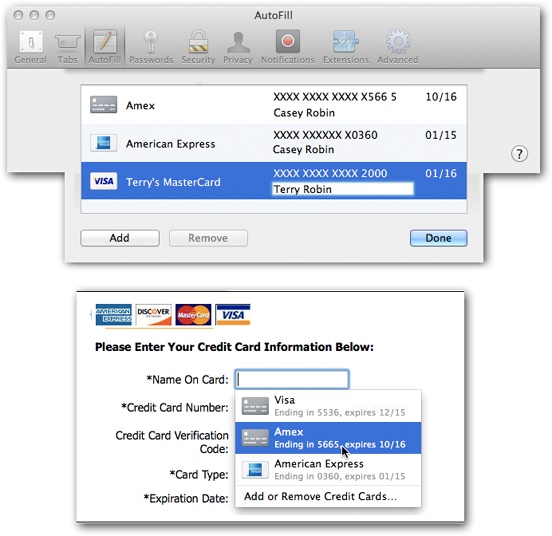Safari can remember user names, passwords, mailing addresses, and other information you type into the text boxes you encounter in your Web travels. And thanks to a new Mavericks feature called the iCloud Keychain, Safari can now memorize your credit card details, too—and synchronize all of it (passwords and credit cards) with your other Apple phones, tablets, and Macs.
To turn on this great feature, visit the Safari→Preferences→AutoFill tab. If you turn on “Using info from my Contacts card,” then whenever you’re supposed to fill in your shipping address on a Web form, you can click the AutoFill button in the address bar to have Safari fill in the blanks for you automatically. (If you don’t see the AutoFill button, then choose Edit→AutoFill Form to do the deed instead.)
Alternatively, just click a text box—Name, for example—and start typing. As soon as Safari recognizes a familiar scrap of your contact information, it displays a pop-up suggestion below the text box. To accept the suggestion, click it (or press the ![]() arrow key and then press Return). To decline it, press Return, or just keep typing.
arrow key and then press Return). To decline it, press Return, or just keep typing.
If, in Preferences, you turn on “User names and passwords,” then each time you type a password into a Web page, Safari offers to memorize it for you. It’s a great time-and brain-saver. (Of course, use it with caution if you share an account on your Mac with other people.)
Turn on Other Forms if you’d like Safari to remember the terms you’ve typed into search engines, shopping sites, online gaming sites, and so on.
Thanks to the Passwords dialog box shown in Figure 12-7, it’s easy to see all the passwords Safari has saved for you—and to delete the ones you want Safari to “forget”—for security reasons, for example.
Figure 12-7. Choose Safari→Preferences→Passwords to see this master list of all the names and passwords Safari has memorized. It’s easy enough to delete one. But maybe the more useful option is the “Show passwords for selected websites” checkbox. After you authenticate with your account password, it shows you the actual passwords for any listings you click instead of the dots.
Tip
Often, you’ll see a note that says, “Safari will not save your password because this Web site requested passwords not be saved.”
Fortunately, you can strike back. Turn on “Allow AutoFill even for websites that requests passwords not be saved” (shown in Figure 12-7). If you haven’t turned on the password-protected screen saver feature described on Dictation & Speech, you’re now warned that you must do so and offered a button that takes you to the relevant pane of System Preferences. From now on, Safari should be able to memorize any password you throw at it.
Here it is, folks: One of the most useful, most important features of OS X Mavericks—or of any operating system, for that matter. Your computer can now make up unguessable Web-site passwords; fill them in automatically; and synchronize them to your other Apple gadgets, like iPhones, iPads, iPod Touches, and other Macs. Basically, you’ll never have to remember another password.
And it’s not just Web-site passwords, either. iCloud Keychain also memorizes your credit card information, WiFi network passwords, and online account names and passwords (Mail, Contacts, Calendar, Facebook, Twitter, LinkedIn).
Getting to this heavenly state, however, requires some fairly bewildering setup slogging. Apple wants to make darned sure that nobody but you is on the receiving end of this very valuable list of passwords; it would be kind of a bummer if your bank and finance passwords somehow got synced to somebody else’s phone.
You probably encountered the setup steps for iCloud Keychain the first time you turned on your Mavericks Mac. It’s also possible that you set up your iOS 7 phone or tablet with iCloud Keychain, in which case you have only to add your Mac to the circle, as described below.
But if this is your first iCloud Keychain setup experience, here’s how it goes.
1. Open System Preferences→iCloud. Turn on Keychain.
If your Mac doesn’t require your password when you wake it up or log in, then OS X now recommends that you take a moment to set that up. (Otherwise, a bad guy could get in to see all your passwords.) Click either Not Now or Open Security & Privacy and then proceed as described on Dictation & Speech.
Next, the Mac asks you to supply your iCloud account password (iCloud).
2. Enter your iCloud password and click OK.
You’re now asked to make up a new password—a security code—just for your iCloud Keychain, as shown in Figure 12-8.
Tip
If you click Advanced at this point, you’re offered three alternatives to the four-digit security code. See the box on Alternatives to the Four-Digit Security Code.
3. Make up a four-digit security code. Type it in; click Next. Enter it a second time, and click Next again.
Now the Mac asks you to supply a cellphone number; when you try to set up another Apple gadget to work with iCloud Keychain, Apple will send a special verification code to this phone number.
If you don’t have a cellphone, you can either enter the cellphone number of somebody you trust or choose the “Don’t create security code” option described in the box on Alternatives to the Four-Digit Security Code.
5. Enter your cellphone number; click Done.
You’re all set. This one Mac can now auto-generate passwords for you, and your passwords are being backed up in iCloud.
But the real payoff doesn’t come until you add other Apple gadgets to the great iCloud Keychain archipelago. That’s when all of your hard-won passwords are wirelessly and automatically synced to your phone, tablet, or whatever, so you don’t ever have to remember them or type them. Read on.
Figure 12-8. Turning on iCloud Keychain involves making up a special passcode, which will come in handy later when you add other Apple gadgets to the keychain syncing (or when you lose your Apple gadgets). If you make up something obvious, like 0000 or 1234, you’ll be scolded for your lack of creativity and offered a chance to make up something harder to guess.
To add another Mac (running OS X Mavericks or later) to your magical keychain syncing, follow steps 1 and 2 above.
Now you’re offered two ways of confirming your you-ness (Figure 12-9, top):
Request Approval. A message appears, letting you know that a request for approval has just been sent to all your other Apple products (well, at least the ones signed in with your iCloud account). Click OK.
And sure enough: A notification bubble now appears on your Mavericks Macs and iOS 7 phones and tablets (Figure 12-9, bottom).
If the request for approval appears on a Mac, tap View; the iCloud pane of System Preferences opens, bearing a note about another device requesting approval. Click Details; enter your iCloud password; click Allow. The deed is done.
If the request for approval appears on an iPhone, iPad, or iPod Touch, just enter your iCloud password (Figure 12-9, bottom); click Allow. That’s it.
Use Code. You’re asked for the four-digit security code you made up in step 3 above. Enter it, then hit Next.
In a moment, the phone whose number you entered in step 5 gets a text message! It bears a special message from the Apple mother ship: a six-digit verification code. Type it into the Mac, and then click OK.
Figure 12-9. Top: Two ways to add a new Mac to your wireless Keychain syncing: Use the code you made up or use another Apple gadget you own. Bottom: If you opt for the Request Approval option, a message like this appears on your iPhone or iPad. You’re using it to prove your authenticity instead of using the iCloud Keychain security code.
You can repeat the process from additional Macs and iOS devices that you use.
To add an iPhone, iPad, or iPod Touch (with iOS 7.0.3 or later), to the keychain magic, open Settings→iCloud. Turn on Keychain. Turn on iCloud Keychain.
Enter your iCloud password. After a moment, you’re offered an Approve with Security Code button. Tap it.
You’re now asked to enter a six-digit verification code, which Apple sends to the cellphone you supplied in step 3 above.
Once you’ve typed that in, your new mobile gadget is part of the great syncing circle of life. Read on to find out what that means.
The problem with passwords, of course, is that they proliferate. You may visit dozens or hundreds of Web sites that require you to log in—but the security experts direly warn you not to (a) use a password that you could possibly remember, or (b) use the same password for more than one site. It’s great advice, but just a little silly.
At last, though, there’s a solution: Once you’ve turned on iCloud Keychain, Safari—both on Macs and iOS 7 gadgets—can make up a complex, nonsensical password for you and memorize it. Once it’s memorized, Safari can fill it in for you automatically (see Figure 12-10).
Tip
It’s fine if you have more than one account per Web page—two different Gmail accounts, for example. When you log in, Safari displays a pop-up list of the different name/password combinations it knows, so you can click the one you want.
Figure 12-10. Top: Once you’ve turned on iCloud Keychain, clicking into any empty New Password box on a Web page makes Safari offer a password suggestion like this one. Click it to make it your new password (and to make Safari memorize it). You won’t care that all your passwords are blobs of absurd gibberish like this; the iCloud Keychain auto-syncs them to all your other gadgets, where it fills them in there, too. Middle: Before you go on, Safari wants to know if you’d like this password passed on to all your other Apple computers and gadgets. Usually, the answer is yes, Save Password; isn’t that why you went through all the rigmarole of setting up the iCloud Keychain? Bottom: From now on, when you open a Web page that requires a name and password, Safari fills them in automatically using the telltale yellow background. If it’s guessed correctly, just hit Enter or Log in to proceed.
iCloud Keychain can also store your credit card information, making it infinitely easier to buy stuff online. It’s as easy as 1, 2. Figure 12-11 shows you how to store your credit cards in Safari and how to use them to buy things online.
This feature of iCloud Keychain is a lot like the popular password/credit card keeper programs 1Password and Dashlane—better, really, because it’s free and because it works on iPhones, iPads, and iPod Touches, too.
But in one way, it’s worse: As yet another security layer, Safari doesn’t memorize the security code, also known as the CVV or CV2 code, that you need to complete a credit card transaction. You have to fill that in yourself every time you buy something.
Figure 12-11. Top: Teach Safari your credit card details by choosing Preferences→AutoFill. Click Edit to arrive at this list. Click Add. Fill in a description for your card, the number, your name, and the expiration date. Click Done. Bottom: Next time you’re about to buy something, click inside one of the empty boxes (like Name or Credit Card Number). Safari shows this menu of your cards; click one to fill in all the boxes (except Verification Code).
